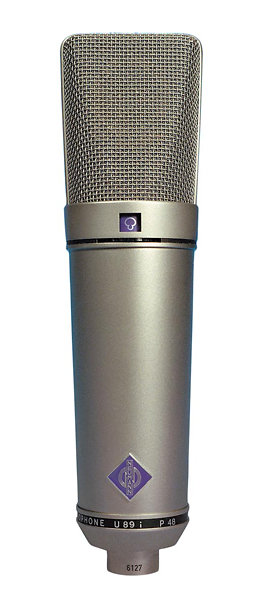Neumann - U89 I
2 749,17 €
excl VAT
with eco participation: 0,07 €
In Stock
Usually shipped within 3 days
+infos
Warranty 3 years
Static Microphone
more sophisticated version of the classic model U 87. His five directional, high-pass filter its two-position switchable attenuator and provide maximum flexibility
ARTICLE N° 9276
Specifications
-
The U 89 is a studio microphone universal in its applications.
-
Its gate protects a dual-diaphragm capsule.
-
A rotary switch under the grid can choose from five different directional; therefore, the microphone is adapted easily to large sound sources, when the musicians are scattered over a large width or a long-distance recording.
-
The amplifier accepts undistorted sound pressure levels up to 134 dB - a figure that may rise to 140 dB.
-
Another rotary switch activates a high-pass filter, operating from 80 Hz or 160 Hz.
-
Acoustic operating principle Pressure gradient transducer
-
Directional Omnidirectional, wide cardioid, cardioid, hypercardioid, (Figure 8)
-
Frequency response 20 Hz to 20 kHz
-
Sensitivity at 1 kHz into 1 kohm 8 mV / Pa
-
Rated impedance 150 Ohms
-
Recommended Load Impedance 1 kOhm
-
Noise level reduced to the entrance, according to CCIR 468-3 28 dB
-
Reduced noise level to entry, DIN / IEC 17 651 dB (A)
-
Report Signal / Noise according to CCIR 468-3 66 dB
-
Signal / Noise to DIN / IEC 77 651 dB
-
Maximum SPL for THD = 0.5% 134 dB
-
Maximum SPL for THD = 0.5%, pre-attenuation activated 140 dB
-
Maximum output voltage 800 mV
-
Dynamic Range mic preamp built according to DIN / IEC 651 117 dB
-
Ghost Supply voltage 48 V ± 4 V
-
Current consumption 0.8 mA
-
Output connector XLR 3M
-
Weight 400 g
-
Diameter 46 mm
-
Length 185 mm
Information
Capsule type
Capacitor
Application
Drum / percussions, Singing, Speaking voice, Piano, Strings instruments
Directivity
Bidirectional (Figure-8), Cardioid, Hypercardioid, Supercardioid, Omnidirectional
Switchable pad
Yes
Switchable Bass-Cut filter
Yes
Shockmount included
No
Power supply
Via +48 V phantom power supply
Color
Nickel
Connectors
XLR male 3 pins
Packaging
Single unit
To go further...
Applications
The look of the U 89 is similar to the U 87 - but it is smaller and lighter, and offers five different polar patterns (instead of three) and a higher maximum level of sound pressure. This microphone lends itself more easily to different applications.
Directional
To the usual directional (omni, cardioid and bidirectional), we have added a hypercardioid and wide cardioid position. Compared to a standard cardioid pattern, the hypercardioid more effectively attenuates sounds from the sides. As for the wide cardioid, it is very convenient to record sound sources deployed on a certain openness.
Acoustic characteristics
The microphone is side impact - the Neumann logo is facing the sound source. The capsule large diameter membrane has a very flat frequency response for all directivities over a wide angle. The frequency response curves are flat up to 10 kHz, with a pickup angle of ± 100 °.
Therefore, the U 89 i has a very even diffuse response field for all directivities; an important aspect in a reverberant environment where thoughts come from all sources on the microphone capsule. The acoustic information is not affected in their tonal quality at their uptake by the microphone.
These characteristics are obtained without the use of corrective resonance effects.
The capsule is elastically mounted to avoid any structure borne noise path.
Filtering and mitigation
The integrated microphone preamp accepts undistorted sound pressure levels up to 134 dB. Given a self-noise of 17 dB (A), the total dynamic range is 117 dB. The maximum sound pressure level may rise to 140 dB SPL when the rotary attenuation switch (-6 dB) is ON.
Another rotary switch under the gate enables a high-pass filter switchable cutoff frequency, 80 Hz or 160 Hz. This filter eliminates interference in the grave, but maintains a flat frequency response, even taking a short distance when proximity effect could distort the sound spectrum.
LIN position, the high-pass filter is very low in the spectrum, with a very steep slope, to avoid overloading of the output transformer by undesirable subsonic frequencies.
Safety and reliability
All exposed surfaces of the capsule, including membranes, are at ground potential. This technology makes them immune to electrical and atmospheric interference and contamination by particles and microscopic dust.
The look of the U 89 is similar to the U 87 - but it is smaller and lighter, and offers five different polar patterns (instead of three) and a higher maximum level of sound pressure. This microphone lends itself more easily to different applications.
Directional
To the usual directional (omni, cardioid and bidirectional), we have added a hypercardioid and wide cardioid position. Compared to a standard cardioid pattern, the hypercardioid more effectively attenuates sounds from the sides. As for the wide cardioid, it is very convenient to record sound sources deployed on a certain openness.
Acoustic characteristics
The microphone is side impact - the Neumann logo is facing the sound source. The capsule large diameter membrane has a very flat frequency response for all directivities over a wide angle. The frequency response curves are flat up to 10 kHz, with a pickup angle of ± 100 °.
Therefore, the U 89 i has a very even diffuse response field for all directivities; an important aspect in a reverberant environment where thoughts come from all sources on the microphone capsule. The acoustic information is not affected in their tonal quality at their uptake by the microphone.
These characteristics are obtained without the use of corrective resonance effects.
The capsule is elastically mounted to avoid any structure borne noise path.
Filtering and mitigation
The integrated microphone preamp accepts undistorted sound pressure levels up to 134 dB. Given a self-noise of 17 dB (A), the total dynamic range is 117 dB. The maximum sound pressure level may rise to 140 dB SPL when the rotary attenuation switch (-6 dB) is ON.
Another rotary switch under the gate enables a high-pass filter switchable cutoff frequency, 80 Hz or 160 Hz. This filter eliminates interference in the grave, but maintains a flat frequency response, even taking a short distance when proximity effect could distort the sound spectrum.
LIN position, the high-pass filter is very low in the spectrum, with a very steep slope, to avoid overloading of the output transformer by undesirable subsonic frequencies.
Safety and reliability
All exposed surfaces of the capsule, including membranes, are at ground potential. This technology makes them immune to electrical and atmospheric interference and contamination by particles and microscopic dust.
You may also like
Accessories
Neumann - U89 I
Neumann - U89 I
2 749,17 €
excl VAT
with eco participation: 0,07 €
In Stock
Usually shipped within 3 days
+infos
Warranty 3 years
Spotlight on
A legendary brand for decades, present in all the major recording studios, Neumann is a guarantee of high quality and professionalism. The Beatles, Natalie Cole, Celine Dion, Bryan Adams and Beyoncé... all use this exceptional brand with the famous U87, and the TLM49 at the top of the list. In home studio, the TLM103 and TLM102 condenser microphones are the most popular. For studio sound on stage opt for the KMS105. In recent years, Neumann has also offered the high-end KH80, KH120 and KH310 monitors.







